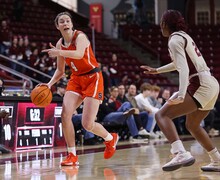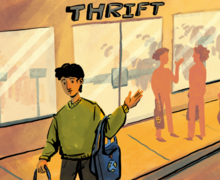SU invested $13.1 million in classroom renovations and accessibility upgrades over the summer
Cathy Doherety | Contributing Photographer
Syracuse University has spent $9 million to renovate and upgrade accessibility of various classrooms during this summer.
UPDATED: Sept. 1 at 11 a.m.
Despite most of the attention being on the University Place promenade renovation, students may start to notice other changes that have occurred since they last roamed campus.
Over the summer, $13.1 million was poured into upgrading various classrooms with new furniture and technology, in accordance with the Campus Framework.
The Division of Information Technology Services and Campus Planning, Design and Construction joined forces to upgrade technology and academic spaces, according to an SU news release.
More than a dozen buildings on campus received upgrades. Pete Sala, vice president and chief facilities officer, said in an email that this work is significant and will have a palpable impact on students, faculty and staff.
“Technology upgrades in our classrooms are commonly part of larger renovations that are being made to those spaces,” said Samuel Scozzafava, vice president for ITS and chief information officer, in an email. “Thus, in many cases CPDC and ITS are partners in completing a full range of updates that not only include technology upgrades but a myriad of other facilities upgrades, as well.”
The technological upgrades include audio and visual system upgrades, new smart teaching stations and, in some rooms, complete technology upgrades, changes that Scozzafava said will be noticeable.
It is technology upgrades like these that made it possible for the Department of Physics’ role in the discovery of gravitational waves — proving Albert Einstein’s theory of general relativity, which occurred last February — Scozzafava said in the release.
“Student and faculty experience is at the forefront of our decision making,” Scozzafava said. “Our goal is to provide technology that enhances teaching and learning in as many ways as possible.”
In addition to technological upgrades, work included accessibility improvements, furniture replacements and changes to lighting, heating, air conditioning and ventilation, said Joseph Alfieri, director of CPDC, in an email. He noted that these changes contribute to an environment that is more comfortable and conducive to learning.
In early August, construction was completed on the third floor of the Heroy Geology Building to form a new academic area that now houses the National Science Foundation Research Traineeship Program, which is the result of a $3 million NSF grant awarded to SU’s Education Model Program on Water-Energy Research, or EMPOWER. in April 2015, according to the release. The program involves faculty from the College of Arts and Sciences, the College of Engineering and Computer Science, the Maxwell School of Citizenship and Public Affairs and the S.I. Newhouse School of Public Communications.
“It’s a nice study or workspace for students in the Earth sciences department and others involved with the grant,” said Deanna McCay, program manager for EMPOWER NRT.
The space features three faculty office spaces, two conference rooms and a study area for students, complete with chairs that feature built-in outlets, lamps, swiveling table tops and a footstool.
McCay noted that, although construction is complete, they will continue to upgrade the space, namely with a new sectional couch.
“The funds to support the classroom enhancements and the technology upgrades come from project funds in the Office of Information Technology Services and the Office of Campus Planning, Design and Construction,” Scozzafava said. “We are constantly communicating between offices to identify areas on campus where we can improve the teaching and learning experience.”
Sala said the CPDC develops and manages an annual budget that is used for updating classrooms, infrastructure repairs and ADA improvements.
While most of the upgrades scheduled for the summer have been completed, Scozzafava said that technology upgrades happen year-round.
Notably, the auditorium on floor one of Link Hall is still in the renovation process, and the work will be completed in off hours this September, Alfieri said.
Plans are already in motion for classroom upgrades to occur over winter break as well as during the summer of 2017, Scozzafava said.
Scozzafava worked closely with Pete Sala, vice president and chief facilities officer, to coordinate scheduling and resourcing for the upgrades.
“I’m excited for our students to experience Syracuse University this semester and look forward to hearing their feedback over the next several weeks,” Sala said.
CORRECTION: In a previous version of this article, SU’s combined investment was misstated. The university invested $13.1 million in campus accessibility renovations and classroom upgrades, not $9 million. The Daily Orange regrets this error.
Published on August 31, 2016 at 10:24 pm
Contact Taylor: tnwatson@syr.edu





